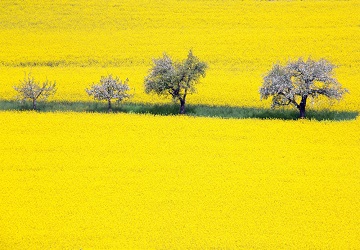|
|
|
|
|
光系统II亚基S过表达可增加田间种植作物的用水效率 |
|
|
论文标题:Photosystem II Subunit S overexpression increases the efficiency of water use in a field-grown crop
期刊:Nature Communications
作者:Krishna K. Niyogi & Stephen P. Long et al
发表时间:2018/03/06
数字识别码:10.1038/s41467-018-03231-x
原文链接:https://www.nature.com/articles/s41467-018-03231-x?utm_source=Other_website&utm_medium=Website_links&utm_content=RenLi-Nature-Nature_Comms-Plant_Sciences-China&utm_campaign=NATCOMMS_USG_JRCN_RL_sciencenet_PhotosystemII_Aug_2nd

2018年3月,《自然-通讯》发表了一篇名为Photosystem II Subunit S overexpression increases the efficiency of water use in a field-grown crop的研究。全球大部分粮食作物都依赖于灌溉,不光消耗着全球地下水,并使全球粮食生产的可持续性面临风险。为了在光合作用过程中捕获大气中的二氧化碳,作物的气孔需要保持开放状态,以使二氧化碳扩散到叶中。然而,气孔开放导致植物根系吸收的大部分水分通过蒸腾作用而流失。在该研究中来自美国伊利诺伊大学的Stephen P. Long等学者揭示了PsbS(Photosystem II Subunit S,光系统II亚基S)的表达对植物气孔开放的影响。
作物生产供水不足是实现2050年粮食产量增长70%的障碍。其中一种解决方案是开发每单位生产量需要较少水分的作物。叶片中开放的气孔不仅可以发生水汽的蒸腾,也促进了光合作用中CO2的流入。作者假设PsBs的表达会影响与叶绿体相关的信号,而该信号对光有响应并控制着气孔的开放,这一现象可用于改善水利用效率。作者构建了一系列转基因烟草植物,其PsbS的表达量从痕量到3.7倍于野生型不等。在光照条件下,PsbS表达增加的植物有较少的气孔开放,这导致在田间条件下CO2同化的水分损失平均减少25%。由于PsbS在高等植物中起到的效果是普遍的,所以这种操作应该对所有作物均有效。
摘要:Insufficient water availability for crop production is a mounting barrier to achieving the 70% increase in food production that will be needed by 2050. One solution is to develop crops that require less water per unit mass of production. Water vapor transpires from leaves through stomata, which also facilitate the influx of CO2 during photosynthetic assimilation. Here, we hypothesize that Photosystem II Subunit S (PsbS) expression affects a chloroplast-derived signal for stomatal opening in response to light, which can be used to improve water-use efficiency. Transgenic tobacco plants with a range of PsbS expression, from undetectable to 3.7 times wild-type are generated. Plants with increased PsbS expression show less stomatal opening in response to light, resulting in a 25% reduction in water loss per CO2 assimilated under field conditions. Since the role of PsbS is universal across higher plants, this manipulation should be effective across all crops.
阅读论文全文请访问:https://www.nature.com/articles/s41467-018-03231-x?utm_source=Other_website&utm_medium=Website_links&utm_content=RenLi-Nature-Nature_Comms-Plant_Sciences-China&utm_campaign=NATCOMMS_USG_JRCN_RL_sciencenet_PhotosystemII_Aug_2nd
(来源:科学网)
特别声明:本文转载仅仅是出于传播信息的需要,并不意味着代表本网站观点或证实其内容的真实性;如其他媒体、网站或个人从本网站转载使用,须保留本网站注明的“来源”,并自负版权等法律责任;作者如果不希望被转载或者联系转载稿费等事宜,请与我们接洽。